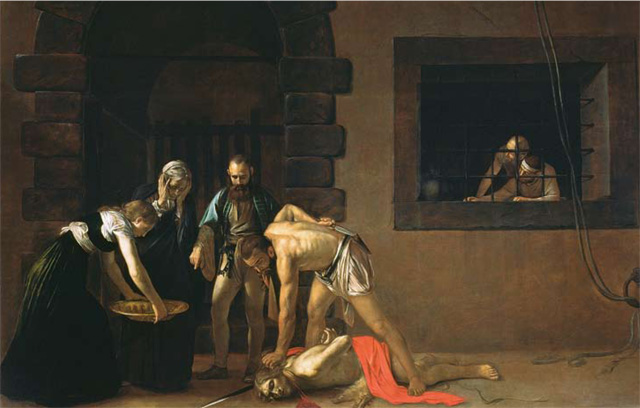My Favourite Painting: Charles Saumarez Smith
Charles Saumarez Smith chooses his favourite painting for Country Life.


Beheading of John the Baptist, 1608, 205in by 142in, by Michelangelo Merisi da Caravaggio (1571–1610), St John’s Co-Cathedral, Valletta, Malta. Bridgeman Images.
Charles Saumarez Smith says: ‘The picture that has made by far the greatest impact on me in recent years was when I travelled to Malta to see Caravaggio’s astonishing painting of the Beheading of St John the Baptist, which fills the whole space of the Oratory off one of the aisles of Malta Cathedral with its intense, hyper-dramatic realism.’
Charles Saumarez Smith is secretary and chief executive of the Royal Academy of Arts.
Art critic John McEwen comments: 'This is Caravaggio’s largest painting and the only one with his signature. It is also the first instance in art history of space as a dramatic element. The Caravaggio revival dates from a 1951 exhibition. Since then, he has become a cult figure, art’s bad boy, a subject for T-shirts. But his importance is that his boldly designed and vividly life-like religious paintings embody the spiritual fervour of the Catholic Counter-Reformation. That Christianity today awaits similar resurgence against similar enemies only emphasises his pertinence.
The aristocratic Knights of Malta were the ultimate exemplars of Counter-Reformation Christian chivalry. Caravaggio fled from Rome to Malta as a wanted man, having killed a rival in a fight. He sought forgiveness through admission to the Order and, as a famous painter with loyal and noble patrons, he was welcomed by the Grand Master. This great altarpiece was his passagio, the gift presented on becoming a Knight.
The beheading is more grisly for its perfunctoriness. The Baptist has been untied, but still lies like a tethered animal. Only the old woman shows feeling. Yet for all its truth to life, the scene is not natural. The lighting in the looming darkness is theatrical, the crimson cloak a metaphor of martyred blood. Caravaggio’s signature is scrawled in the ‘actual’ blood. Make of that what you will. Caravaggio was no sooner made a Knight than he was banished, another brawl forcing him on the run again. He died of a fever at Porto Ercole on his way back from exile to Rome.'
This article was first published in Country Life, January 5, 2011
Sign up for the Country Life Newsletter
Exquisite houses, the beauty of Nature, and how to get the most from your life, straight to your inbox.
Country Life is unlike any other magazine: the only glossy weekly on the newsstand and the only magazine that has been guest-edited by HRH The King not once, but twice. It is a celebration of modern rural life and all its diverse joys and pleasures — that was first published in Queen Victoria's Diamond Jubilee year. Our eclectic mixture of witty and informative content — from the most up-to-date property news and commentary and a coveted glimpse inside some of the UK's best houses and gardens, to gardening, the arts and interior design, written by experts in their field — still cannot be found in print or online, anywhere else.
-
 Six rural properties with space, charm and endless views, as seen in Country Life
Six rural properties with space, charm and endless views, as seen in Country LifeWe take a look at some of the best houses to come to the market via Country Life in the past week.
By Toby Keel
-
 Exploring the countryside is essential for our wellbeing, but Right to Roam is going backwards
Exploring the countryside is essential for our wellbeing, but Right to Roam is going backwardsCampaigners in England often point to Scotland as an example of how brilliantly Right to Roam works, but it's not all it's cracked up to be, says Patrick Galbraith.
By Patrick Galbraith
-
 My favourite painting: Allan Mallinson
My favourite painting: Allan MallinsonMilitary historian Allan Mallinson picks an image of 'faith, generosity and ultimate sacrifice'.
By Charlotte Mullins
-
 My Favourite Painting: Piet Oudolf
My Favourite Painting: Piet Oudolf'One cannot sense whether he is far out on the ocean or closer to shore, or what he may be watching or feeling in that moment as he stares towards the beach.’
By Country Life
-
 My Favourite Painting: Mary Plazas
My Favourite Painting: Mary Plazas'There is compassion, awe, humility, a knowing yet a questioning in the glistening eyes. It moves me, it inspires me beyond the need to know.’
By Country Life
-
 My favourite painting: Robert Kime
My favourite painting: Robert KimeRobert Kime shares his fondness for New Year Snow by Ravilious
By Country Life
-
 My Favourite Painting: Anna Pavord
My Favourite Painting: Anna PavordAnna Pavord chooses a picture which reminds her of where she grew up
By Country Life
-
 My favourite painting: The Duchess of Wellington
My favourite painting: The Duchess of WellingtonThe Duchess of Wellington chooses her favourite painting for Country Life.
By Country Life
-
 My favourite painting: Maureen Lipman
My favourite painting: Maureen LipmanMaureen Lipman chooses her favourite painting for Country Life.
By Country Life
-
 My favourite painting: Jacqueline Wilson
My favourite painting: Jacqueline Wilson'I looked at this painting and decided to write about a Victorian circus girl one day'
By Country Life